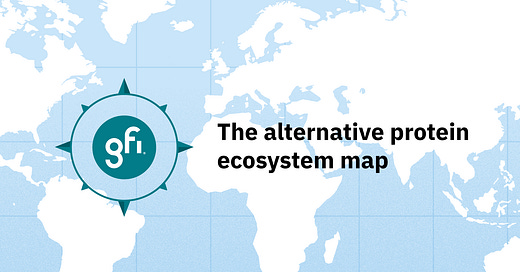Putting alt proteins on the map – literally
Take a trip around the world with our new alternative protein ecosystem map
Are you familiar with a company using fermentation to create climate-resilient protein in Ethiopia?
What about a researcher looking at serum-free media for cultivated meat in Serbia?
Did you know about the company developing alternative protein products using seaweed in Chile?
On its face, the alternative protein industry may seem like a niche movement, representing well under one percent of the global meat market. But when you zoom out, you can see the ripple effects of an entire international community working tirelessly to build the future we all know is possible – a future where alternative proteins are no longer alternative.
When you look at the bigger picture, you’ll also understand why the growth of this industry is so important. Transitioning toward alternative proteins can dramatically reduce emissions, require far less land, eliminate the use of antibiotics in our food system, and feed more people with fewer resources.
The alternative protein sector has grown tremendously since I started at GFI five years ago. In my work, it’s easy to see the alternative protein field not just as a food system but as a human system – a collection of students, scientists, educators, policymakers, entrepreneurs, and investors working hard to build the conditions for a more sustainable, secure, and just food system to take root.
Those of us at GFI spend every day connecting the dots across this burgeoning sector. When we realized there wasn’t a tool that showcased the vast global network in this industry, we got to work to build something that could capture that. Thus, the alternative protein ecosystem map was born.
What is the alternative protein ecosystem map?
The ecosystem map is a public-facing web resource that allows users to easily visualize and interact with geographical "hot spots" of alternative protein activity across the globe. GFI tracks and curates an incredible amount of information across sectors. However, until now there hasn’t been a way for our communities to easily look across datasets to understand patterns and clusters of activity. We hope this tool will change that, especially as the ecosystem grows. But, this is a living resource that doesn’t reflect everyone – at least not yet.
Currently, the ecosystem map contains three data layers: specialized companies from our company database, researchers from our researcher directory, and active student groups in the Alt Protein Project. We know there are many more individuals and entities out there who are part of this project to create a vibrant protein supply that serves everyone. In the future, we plan to include additional data layers such as research centers, education and training programs, and production facilities.
Help us complete the picture
The alternative protein field is not a monolith — it is a growing movement comprising many vibrant disciplines, communities, and cultures around the globe all trying to build a better food system for all.
While this map illuminates the areas where alternative protein activity is happening in full force, it also shines a light on the areas where we still have work to do in inviting everyone to the table.
We need your help filling in the blanks! Add yourself or your organization to the map. Share with your networks. Connect with others who might help support your work. Encourage your communities to join the food system we’re building.
Reimagining a complex, global food system is a daunting task. In this collective diversity, I hope we can find the motivation, resilience, connection, and imagination to sustain our efforts – brick by brick, or in this case, pin by pin.







